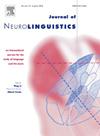经验语言和新学语言中基于理解的语言转换:来自诱导大脑振荡的证据
IF 1.2
3区 心理学
Q2 LINGUISTICS
引用次数: 0
摘要
在说和听的过程中,双语者能够通过复杂的控制过程在两种语言之间无缝切换。在本研究中,我们使用脑电图(EEG)和时间频率表征(TFR)分析来研究基于理解的经验语言和新学语言之间的切换。双语者用两种经验语言(汉语和英语)和两种新学语言(德语和日语)完成听觉图片-词语匹配任务。行为结果显示,在经验语言之间进行转换时,转换成本不对称,中文转换成本大于英文,但在两种新学语言之间没有转换成本。TFR分析结果发现,对于有经验的语言,切换试验会导致delta和theta波段的功率下降,而对于两种新学习的语言,切换试验会导致theta和alpha波段的功率下降。这些发现强调了语言控制的动态性质,并为动态重组模型提供了证据。本文章由计算机程序翻译,如有差异,请以英文原文为准。
Comprehension-based language switching in experienced and newly learned languages: Evidence from induced brain oscillations
When speaking and listening, bilinguals have the ability to seamlessly switch between their two languages using complex control processes. In the present study, we use electroencephalography (EEG) and time-frequency representation (TFR) analyses to investigate comprehension-based switching between experienced and newly learned languages. Bilinguals performed an auditory picture-word matching task in two experienced languages (Chinese and English) and in two newly learned languages (German and Japanese). The behavioral results revealed asymmetrical switch costs when switching between experienced languages, with larger costs in Chinese than in English, but no costs between the two newly learned languages. The results of the TFR analyses found that for the experienced languages, switch trials induced a power decrease in delta and theta bands, while for the two newly learned languages, switch trials led to a power decrease in the theta and alpha bands. The findings underscore the dynamic nature of language control and provide evidence for the Dynamic Restructuring Model.
求助全文
通过发布文献求助,成功后即可免费获取论文全文。
去求助
来源期刊

Journal of Neurolinguistics
医学-神经科学
CiteScore
3.90
自引率
5.00%
发文量
49
审稿时长
17.2 weeks
期刊介绍:
The Journal of Neurolinguistics is an international forum for the integration of the neurosciences and language sciences. JNL provides for rapid publication of novel, peer-reviewed research into the interaction between language, communication and brain processes. The focus is on rigorous studies of an empirical or theoretical nature and which make an original contribution to our knowledge about the involvement of the nervous system in communication and its breakdowns. Contributions from neurology, communication disorders, linguistics, neuropsychology and cognitive science in general are welcome. Published articles will typically address issues relating some aspect of language or speech function to its neurological substrates with clear theoretical import. Interdisciplinary work on any aspect of the biological foundations of language and its disorders resulting from brain damage is encouraged. Studies of normal subjects, with clear reference to brain functions, are appropriate. Group-studies on well defined samples and case studies with well documented lesion or nervous system dysfunction are acceptable. The journal is open to empirical reports and review articles. Special issues on aspects of the relation between language and the structure and function of the nervous system are also welcome.
 求助内容:
求助内容: 应助结果提醒方式:
应助结果提醒方式:


